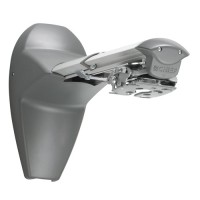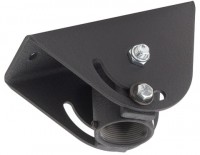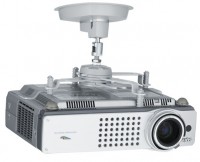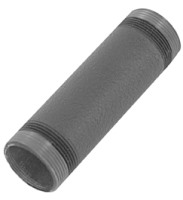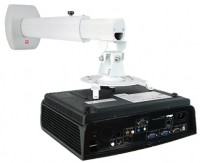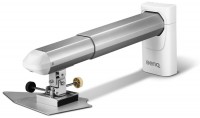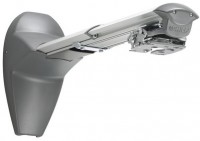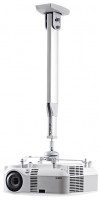Projector Mounts Chief
All Projector Mounts Advanced filters → |
You might be interested in
Projector Mounts: specifications, types
Type
The type determines the design features of the mount. Depending on this, the projector can be placed on the wall, under the ceiling or almost anywhere in the room on a special projector stand.
— wall mount. In terms of design, this solution is very similar to ceiling brackets, with the only difference being that the mounting is not on the ceiling, but on a side wall or any other vertical surface. Mostly, such a solution is used if it is necessary to place a short throw projector or it is simply not possible to install a ceiling bracket.
— ceiling mount. This type of bracket is designed to fit comfortably under the ceiling where it will not disturb anyone. This is one of the most popular options for home, office, auditorium or conference room. Cable management will give the whole structure a more aesthetic appearance (see "Cable management "). As for the shortcomings, it should be noted the complexity of the installation and the inability to quickly remove the projector in order to move it to another room.
— wall/ceiling mount. As mentioned above, wall and ceiling mounts are very similar in design, and therefore many brackets can be used in both versions. This may prove to be a more versatile solution, but at the same time, the ability to adjust the position of the projector in such models is more limited than in traditional wall or ceiling models.
— projector stand. In this case, it is not a bracket for wall placement of the projector, but a special stand that can be moved to another room at any time. The possibility of transportation is the main advantage of such solutions, in comparison with those described above. Usually such stands are equipped with wheels for easy transportation, as well as clamps for fixation in one position. It can serve as a good solution for schools, universities, etc.
— wall mount. In terms of design, this solution is very similar to ceiling brackets, with the only difference being that the mounting is not on the ceiling, but on a side wall or any other vertical surface. Mostly, such a solution is used if it is necessary to place a short throw projector or it is simply not possible to install a ceiling bracket.
— ceiling mount. This type of bracket is designed to fit comfortably under the ceiling where it will not disturb anyone. This is one of the most popular options for home, office, auditorium or conference room. Cable management will give the whole structure a more aesthetic appearance (see "Cable management "). As for the shortcomings, it should be noted the complexity of the installation and the inability to quickly remove the projector in order to move it to another room.
— wall/ceiling mount. As mentioned above, wall and ceiling mounts are very similar in design, and therefore many brackets can be used in both versions. This may prove to be a more versatile solution, but at the same time, the ability to adjust the position of the projector in such models is more limited than in traditional wall or ceiling models.
— projector stand. In this case, it is not a bracket for wall placement of the projector, but a special stand that can be moved to another room at any time. The possibility of transportation is the main advantage of such solutions, in comparison with those described above. Usually such stands are equipped with wheels for easy transportation, as well as clamps for fixation in one position. It can serve as a good solution for schools, universities, etc.
In box
— Mounting kit. A complete kit that includes everything you need to install the projector. The vast majority of modern mounts are sold in this configuration.
— Mounting base/rod. The presence in the kit of at least a mounting base (parts attached to the wall/ceiling), and in some models — also rods. Buying a new base is justified in cases where the existing one does not fit, for example, in terms of installation features, and it makes no sense to change the entire mount. And the “base + rod” kit requires only a mounting plate for turning into a full-fledged mount; this option allows user to keep the existing mounting plate at the projector and not overpay for a new one.
— Rod. The rod connects the mounting base (an element that is attached to the wall or ceiling) to the mounting plate (the projector itself is mounted on it). By replacing this part, you can not only fix the mount in case of some breakdowns, but also expand its capabilities — for example, install a telescopic rod instead of an unregulated rod.
— Mounting plate. Mounting part to which the projector is attached. The purchase of such a part makes sense primarily in cases where the original mounting plate is broken or lost; such situations rarely occur, and therefore this configuration option is not very popular.
— Mounting base/rod. The presence in the kit of at least a mounting base (parts attached to the wall/ceiling), and in some models — also rods. Buying a new base is justified in cases where the existing one does not fit, for example, in terms of installation features, and it makes no sense to change the entire mount. And the “base + rod” kit requires only a mounting plate for turning into a full-fledged mount; this option allows user to keep the existing mounting plate at the projector and not overpay for a new one.
— Rod. The rod connects the mounting base (an element that is attached to the wall or ceiling) to the mounting plate (the projector itself is mounted on it). By replacing this part, you can not only fix the mount in case of some breakdowns, but also expand its capabilities — for example, install a telescopic rod instead of an unregulated rod.
— Mounting plate. Mounting part to which the projector is attached. The purchase of such a part makes sense primarily in cases where the original mounting plate is broken or lost; such situations rarely occur, and therefore this configuration option is not very popular.
Max. weight
Each bracket is designed to withstand a specific weight indefinitely without any consequences. But the safety of its use is not guaranteed if the user exceeds this maximum weight. This does not mean that the bracket will collapse immediately, as soon as you reload it, but this can happen at any time, and such a breakdown is no longer covered by the warranty. Note that the weight of the lightest projectors is about 5 kg, while the weight of professional equipment can exceed 50 kg. Experts recommend purchasing mounts which maximum weight is 20% higher than the weight of the projector.
As for projector stands, here you need to understand that the maximum weight does not mean the weight of the projector that can be installed on the stand, but the total weight of all objects located on it.
As for projector stands, here you need to understand that the maximum weight does not mean the weight of the projector that can be installed on the stand, but the total weight of all objects located on it.
Number of shelves
This parameter characterizes the total number of shelves provided in a particular projector stand. It is worth paying attention to the fact that the shelves can be placed both on different levels, and on one, but at the same time their tilt and height are independently adjustable.
Max. weight for one shelf
The maximum allowable weight per shelf of the projector stand. As with the maximum weight described above (see "Maximum weight"), product integrity is not guaranteed if the user loads the shelf above this value.
Minimum distance from the ceiling
The minimum allowable distance from the ceiling to the nearest protruding attachment point at its highest position. This parameter is primarily important for ceiling mounts, it indicates how close to the ceiling the user can place the projector. If the projector cannot be adjusted in height, then this parameter corresponds to the bracket rod length..
Max. distance from the ceiling
The maximum allowable distance from the ceiling to the nearest protruding attachment point in its lowest position. This setting primarily applies to ceiling mounts and indicates how low the mount can be lowered from the ceiling with the projector mounted on it. It is recommended to mount the projector at the same height as the top edge of the screen. Note that if the design does not provide the possibility of adjusting the height, then this parameter corresponds to the length of the rod.
Minimum distance from the wall
The parameter refers to wall mounts. Indicates the minimum allowable distance from the wall to the nearest protruding attachment point. It shows how close to the wall you can move the mount with the projector mounted on it.
Max. distance from the wall
This parameter only applies to wall brackets and indicates how far away from the wall you can move the bracket with the projector mounted on it. By itself, this feature may not provide much adjustment, but when combined with turn or rotation, it will allow you to find the most comfortable position for the projector.
Adjustments
In most cases, all projector mounts are made in the form of a special movable mechanism that allows the user to adjust the position of the projector relative to the space of the room or the user himself, even after the device is installed on the bracket and the bracket is mounted on the wall. The more adjustment options available, the more convenient the mount can be for home use, as it will allow user to optimally adjust the position of the projector. But there can be a significant difference in price between brackets that are almost identical in appearance, primarily due to additional adjustment options.
— tilt. The projector can be tilted forward or backward to direct the light at the desired angle if the device is above or below the user's eye level. This parameter is very important for projectors that will be installed much lower or higher than the screen, for example, under the ceiling.
— turn. In this case, it means that the projector that already mounted on the bracket can be tilted a few degrees to the left or right relative to a horizontal line or ceiling. This feature will be very useful if the device is installed in a room with an uneven ceiling.
— depth adjustment. The ability to move the projector back and forth relative to the point of attachment to the wall. In fact, this allows you to push the projector towards you, or vice versa...— move it closer to the wall. On its own, this setting has little effect, but when combined with rotation (see "Rotation"), it can improve the usability of the bracket.
— height adjustment. The ability to adjust the height of the projector relative to the point of attachment to the wall. This parameter is of particular importance for ceiling mounts; it is implemented by an adjustable telescopic rod. All modern ceiling mounts can be divided into two broad categories: with a rigid rod of a fixed length and with an adjustable rod.
— rotation. Ability to rotate the projector from side to side around the vertical axis. It can be important if the projection screen can eventually be moved to the other side of the room — in this case, instead of removing the mount itself, user can simply rotate the projector mounted on it. It is also important if the projector is not exactly centered on the projection screen after installation.
— tilt. The projector can be tilted forward or backward to direct the light at the desired angle if the device is above or below the user's eye level. This parameter is very important for projectors that will be installed much lower or higher than the screen, for example, under the ceiling.
— turn. In this case, it means that the projector that already mounted on the bracket can be tilted a few degrees to the left or right relative to a horizontal line or ceiling. This feature will be very useful if the device is installed in a room with an uneven ceiling.
— depth adjustment. The ability to move the projector back and forth relative to the point of attachment to the wall. In fact, this allows you to push the projector towards you, or vice versa...— move it closer to the wall. On its own, this setting has little effect, but when combined with rotation (see "Rotation"), it can improve the usability of the bracket.
— height adjustment. The ability to adjust the height of the projector relative to the point of attachment to the wall. This parameter is of particular importance for ceiling mounts; it is implemented by an adjustable telescopic rod. All modern ceiling mounts can be divided into two broad categories: with a rigid rod of a fixed length and with an adjustable rod.
— rotation. Ability to rotate the projector from side to side around the vertical axis. It can be important if the projection screen can eventually be moved to the other side of the room — in this case, instead of removing the mount itself, user can simply rotate the projector mounted on it. It is also important if the projector is not exactly centered on the projection screen after installation.
Upward rod tilt angle
Capability to adjust the tilt angle of the rod relative to the vertical axis. The wider the angle, the greater the ability to adjust the position of the projector, but the ability to tilt the rod down is more practical. First of all, it is necessary for cases where the mount will be mounted on an uneven ceiling.
Downward rod tilt angle
The maximum angle of the mounting rod tilt down. This allows the light from the projector to be directed at a downward angle, which can be a very useful feature if the projector is mounted well above the top of the screen. The larger this angle, the wider the adjustment possibilities, but in fact this possibility is primarily necessary if the mount is mounted on an uneven ceiling.
Upward tilt angle
The maximum tilt angle of the platform on which the projector is installed is up from the vertical. If it is a ceiling mount, then this feature, usually, remains unclaimed, in contrast to the possibility of tilting down. But for wall mounting, it can be useful, depending on the location of the mount relative to the projection screen.
Downward tilt angle
The maximum tilt angle of the platform with the projector down relative to the vertical. So, if it is a ceiling bracket, then a large tilt angle will provide wider possibilities when choosing an installation location.
Turn angle
The maximum turn angle of the projector already mounted on the mount, relative to the horizontal line, to the right or left. As already mentioned above (see "Adjustments"), this allows you to level the unevenness of the ceiling on which the bracket is installed.
Rotation angle
The possibility of rotation of a projector relative to a vertical axis or a rod is provided. For the vast majority of mounts that have the ability to rotate an already installed projector, this figure is 360°, which allows you to rotate the projector around the rod and direct the light to the desired side of the room.
Cable management
Capability of cable management inside the rod or mounting support in such a way that the cables do not create inconvenience and do not spoil the appearance of the structure. This possibility is provided mainly in modern ceiling and wall models.




